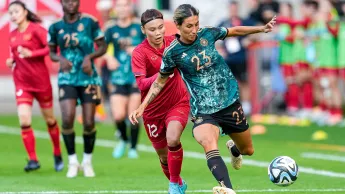Women’s football: prohibited, ridiculed, celebrated
- 2023-08-17
- Ralf Isermann
- Comment

Highly rated – the fall was painful: this was the experience of our German women footballers at the World Cup in Australia and New Zealand. Yet elimination of the co-favourites in the group stage has a positive aspect: the press in Germany has never before dealt so intensively with women’s football after an early departure. This underlines the fact that women’s football is now taken a lot more seriously in Germany. The audience ratings also substantiate that. At the peak there were more than ten million viewers. Anyone who feared that the boom triggered by the UEFA Women’s EURO 2022 has now come to an end is wrong.
Albeit women’s football around the world and in football crazy Germany needs to catch up. The average spectator numbers in the women’s Bundesliga tripled last season to 2,723 spectators per match. Yet the men’s Bundesliga at 42,992 continues to enjoy a lot more spectators. The men are mostly full-time professionals, but over half the Bundesliga’s female professional footballers need to also work in another profession given the huge salary differences. Things have already developed much further in England, Spain and Italy.
This disparity is perhaps due to the fact that the start was difficult. Women’s football in England and France in particular was already booming even before the Second World War. Yet society in Germany found it impossible to accept that women should play football. The Nazis viewed women’s role as that of being mothers. And football in Germany remained a male domain even long after the Second World War. The Deutsche Fußball-Bund (DFB) even banned its clubs from involvement in women’s football in 1955.
Resistance and resilience: the transformation of German women’s football
The women would not however be suppressed: some 60,000 women and girls are reported to have played football in the 60s despite the ban and it was finally lifted in 1970. There are now over a million women and girls taking part in football as members of clubs. This is also a success for the emancipation movement that has been actively campaigning for equality between men and women. It is now scarcely credible that women in Germany were legally obligated to run the household until 1977. It was inconceivable to consider professional female footballers in such an environment.
And it still took until 1986 before a Bundesliga was introduced for women’s football. A little story indicates the low esteem in which women’s football was held at that time: the German women were crowned European Champions in 1989. And every female player was given a coffee set as their win bonus. The German men, who a year later became World Champions, were awarded more than 64,000 euros per player. The women footballers joked about that former win bonus in an advert before the 2019 World Cup. Their trainer Martina Voss-Tecklenburg, who had been a player in 1989 and had also been given a coffee set, grinned as she drank a coffee from the set together with her goalkeeper Almuth Schult and defender Kathrin Hendrich. The background to this is a sense of outdated prejudices regarding women’s football.
Germany's Women's World Cup advert 2019
Captain Alexandra Popp said about the popular advert – Popp is now better known as a footballer than many of her male colleagues. Her recently published autobiography ‘Dann zeige ich es euch eben auf dem Platz’ (Then I’ll just have to prove it to you on the pitch) soon became a bestseller. Former top players like Silvia Neid and Birgit Prinz were far less well known in their time.
There were certainly repeated high points in women’s football globally and in Germany prior to the 2019 World Cup or the 2022 Euros. But these were often just a flash in the pan. There are still only very few women’s matches that are covered live on radio or television. This World Cup year was however the first where FIFA sold the global TV rights separately – they were previously gifted almost as a supplement to the TV rights for men.
Groundbreaking progress: commitment and inclusion
The women have also been praised for being much more committed in terms of many socio-political issues than the men. Their player protest even prevented Saudi Arabia, with its restrictions on women’s rights, from becoming a sponsor of the current World Cup. Women’s football also deals more openly with homosexuality. Details on the website reveal that 96 players at the present World Cup belong to the LGBTQ community. More than ever before. In the case of men’s football, there are hardly any homosexual men. There is also a fan culture in women’s football that is considered to be more peaceful, content and inclusive.
There is currently an exciting attempt to write a new success story in Berlin. Prominent individuals there, such as comedian Carolin Kebekus or the actor Ulrike Folkers, are supporting the female players at Viktoria Berlin. The club aims to achieve rapid promotion to the Bundesliga. But not merely that: ‘Our objective in addition to sporting success is to encourage the advancing transformation in German football and to have a positive influence on society’, writes the club. Those are words that have not yet been heard in men’s football.
